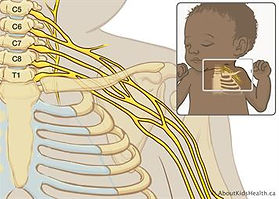Brachial Plexus Injury
What is Brachial Plexus?
What is a Brachial Plexus Injury?

Brachial Plexus (also called Erb's Palsy) is a group of nerves between the bones in the spinal column, leading from the spinal cord to the arms. These nerves allow for feeling and movement in the arms.
Brachial Plexus is described as a pulled, stretched, ruptured or torn nerve in the C5, C6, C7, C8, and/or T1 area of the spinal cord. A Brachial Plexus injury most often occurs during birth, affecting 2-5 in every 1000 babies, affecting more babies than Down's Syndrome and Muscular Dystrophy.
How does this injury occur?
It is usually caused by shoulder distocia, where the baby becomes stuck in the birth canal. A Brachial Plexus injury can also occur due to an accident or sport-related injury, though this is less likely a cause of injury. The damage is to the nerve, not the muscle.

Symptoms
-
Mild, moderate, or severe pain
-
Tingling, burning, or numbness in the arm
-
Arm weakness
-
Loss of sensation
-
Diminished reflexes
Treatment options
There are several treatment options for this injury. Occupational therapy and Physical therapy are the most common treatments. There is also an option for surgery that can include muscles or tendon transfers. A nerve graph is also an option. Doctors first need to determine the extent of the damage to the nerve bundle before treatment plans are made. Rarely, nerves regenerate on their own.

Difficulties in school setting
Children with a Brachial Plexus injury have difficulty lifting their affected arm. This can cause difficulties in gym class, as well as getting on and off the bus. The child may not be able to button or zip jackets, tie shoes, or carry backpacks full of books. Fine motor skills are also affected and can cause trouble with writing and cutting. Gross motor skills are also behind typical developing peers due to lack of equal balance on both sides of the body.
Accommodations Educators can make
To assist a child in your classroom or school with a Brachial Plexus injury, there are several accommodations you can make. Children may need their paper taped to their desk to help keep it steady, as they can't hold the paper with their affected hand. Cutting, coloring, and writing can also cause frustration, and accommodations to the lesson may be needed. Children may also need assistance with lunch/snacks and juice boxes. Additionally, children with this type of injury need extra supervision during physical activities, as they can't brace themselves for a fall. Teachers may also need to observe their students carefully to determine if any other modifications need to be made. Students with this injury may be embarrassed and avoid asking for help. Any activities that may require two hands can potentially need modification.
Additional Links
